Scottish Schools Adolescent Lifestyle and Substance Use Survey (SALSUS): alcohol report 2018
Findings on alcohol from the 2018 wave of the Scottish Schools Adolescent Lifestyle and Substance Use Survey (SALSUS).
This document is part of a collection
4 Attitudes to alcohol use and alcohol education
Acceptability of trying drinking and getting drunk
Just over half of 13 year olds (51%) thought that it was 'ok' for someone their age to try drinking alcohol, while over three-quarters of 15 year olds (79%) thought it was 'ok'.
Among 13 year olds, the acceptability of drinking had been decreasing since 2006. However, between 2015 and 2018, there was an increase in the proportion who thought it was 'ok' to try drinking (from 40% in 2015 to 51% in 2018). There was also a small increase in acceptability among 15 year olds. The proportion thinking that it was 'ok' for someone their age to try alcohol rose from 73% in 2015 to 79% in 2018.
Among 15 year olds, girls were more likely than boys to think that trying an alcoholic drink was 'ok'. There was no statistical difference between 13 year old boys and girls. (Figure 4.1).
Figure 4.1 Acceptability of trying an alcoholic drink, by age and gender (2006-2018)
Q Do you think it is 'ok' for someone your age to do the following? Try drinking alcohol to see what it's like
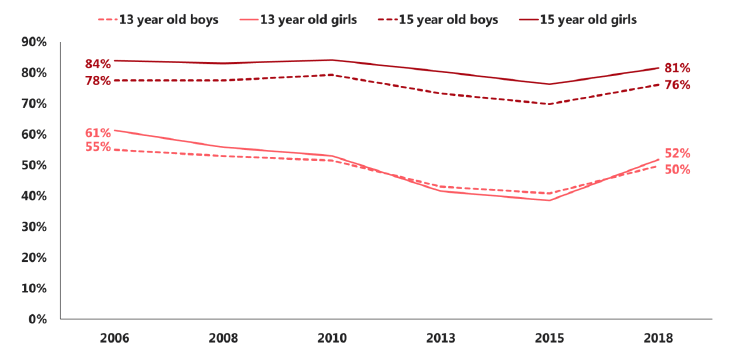
Base: all pupils (for full base size information please see Appendix A)
16% of 13 year olds and 49% of 15 year olds thought that it was 'ok' for someone their age to try getting drunk. This has increased among both age groups since 2015: 9% of 13 year olds thought it was 'ok' to try getting drunk in 2015, compared with 16% in 2018 and 38% of 15 year olds thought this in 2015, compared with 49% in 2018 (the highest it has been since the question was first asked in 2006).
Among both age groups, girls were more likely than boys to think that to try getting drunk was 'ok' (Figure 4.2).
Figure 4.2 Acceptability of trying getting drunk, by age and gender (2006-2018)
Q Do you think it is 'ok' for someone your age to do the following? Try getting drunk to see what it's like
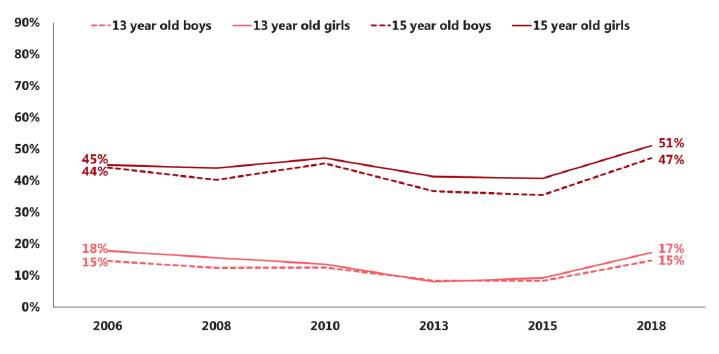
Base: all pupils (for full base size information please see Appendix A)
Alcohol education
Among both age groups, around two-thirds of pupils reported that they had received lessons, videos/DVDs or discussion in class on alcohol in the last 12 months (70% of 13 year olds and 65% of 15 year olds).
Among 13 year old boys, those that had received lessons on alcohol in the last 12 months were less likely to have drank in the last week than those who had not (5% of 13 year old boys who had received lessons had drunk in the last week, compared with 8% of those who had not). However, there was no correlation between school lessons on alcohol use among other groups (13 year old girls, 15 year olds boys and 15 year old girls).
School advice and support
The majority of pupils thought that their school was providing them with enough advice and support about alcohol (71% of 13 year olds and 62% of 15 year olds).
There has been a decrease in the proportion of 15 year olds who agreed that their school provided them with the support they needed from 67% in 2015 to 62% in 2018. However, there was no change among 13 year olds.
While there was no statistical difference in the proportion of 13 year old boys and girls who thought they had enough advice and support about alcohol, there was a difference among 15 year olds: 15 year old girls were less likely to agree that they had enough advice and support than 15 year old boys. This was due to a higher proportion of 15 year old girls choosing neither agree nor disagree, rather than disagreeing that they had enough advice and support (Figure 4.3).
Figure 4.3 Advice and support about alcohol, by age and sex (2018)
Q. To what extent do you agree or disagree with the following statements? 'My school provides me with enough advice and support about…? Drinking alcohol
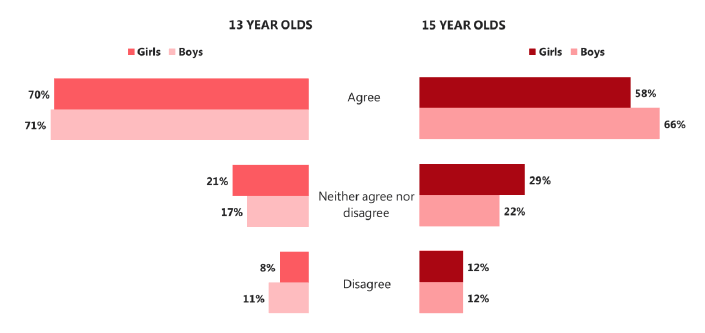
Base: all pupils (13 year boys (5,116), 13 year old girls (5,259), 15 year old boys (4,404) and 15 year old girls (4,657))
Among both age groups, those that agreed that their school provided enough advice and support about alcohol were less likely to have had an alcoholic drink in the last week (Figure 4.4).
Figure 4.4 Comparison of prevalence of drinking alcohol among those who agree/disagree that their school provides them with enough advice and support about alcohol (2018)
Q. To what extent do you agree or disagree with the following statements? 'My school provides me with enough advice and support about…? Drinking alcohol
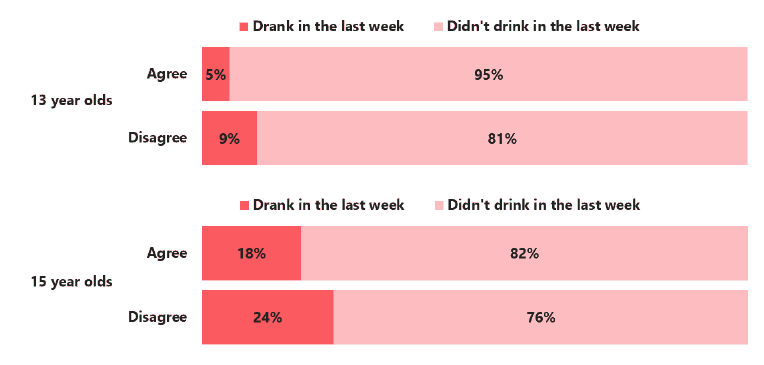
Base: 13 year olds who agree that they receive enough advice and support (7,169), 13 year olds who disagree (1,019), 15 year olds who agree that they receive enough advice and support (5,689), 15 year olds who disagree (1,181)
Amount learned in school about alcohol
Pupils were asked how much they had learned at school about a series of topics relating to alcohol: the risks to health; the effects that alcohol can have on other areas of life; that decision-making can be affected by alcohol; and that people's views about smoking, drinking and drug use can be affected by the things their friends say or do.
Across all four topics, just under half of pupils said that they had learned 'a lot' and a further third said they had learned 'a little' (Figure 4.5).
15 year olds were more likely than 13 year olds to say they had learned about the risks to their health from alcohol and the effects that drinking alcohol can have on other areas of their lives. There were no statistical differences between boys and girls.
Figure 4.5 Amount learned about alcohol at school, by age (2018)
Q. In school, how much have you learned about the following?
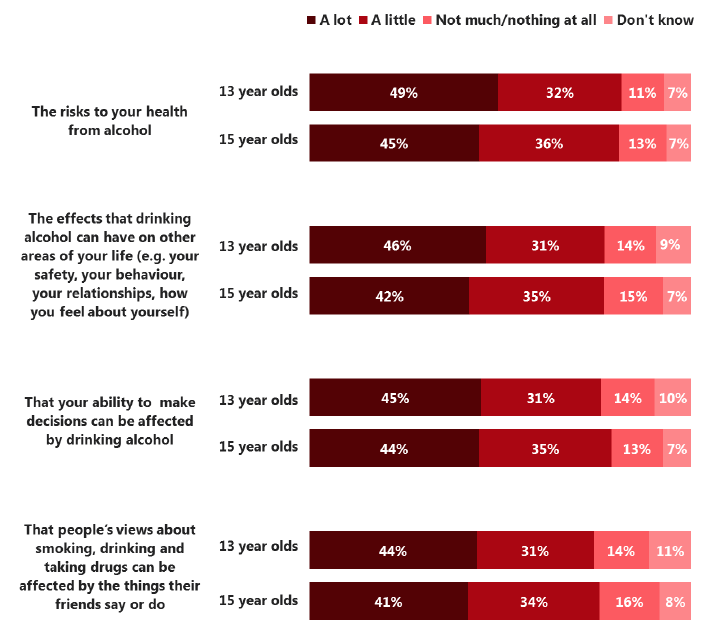
Base: all pupils (for full base size information please see Appendix A)
Across all four alcohol topics, there was a relationship between pupils' drinking behaviour and whether they felt that they had learned something about alcohol. Those that said they had learned a lot were less likely to have had a drink in the last week than those who said they had learned not much or nothing at all (Figure 4.6).
For example, among 15 year olds, 18% of those who said they had learned a lot about the risks to their health, and 19% of those who said they had learned a little, had drank in the last week. Of those who said they had learned not much or nothing at all, 25% had a drink in the last week.
Table 4.6 Comparison of prevalence of alcohol use among 13 year olds, by how much they said they had learned about alcohol topics at school (2018)
Q. In school, how much have you learned about the following?
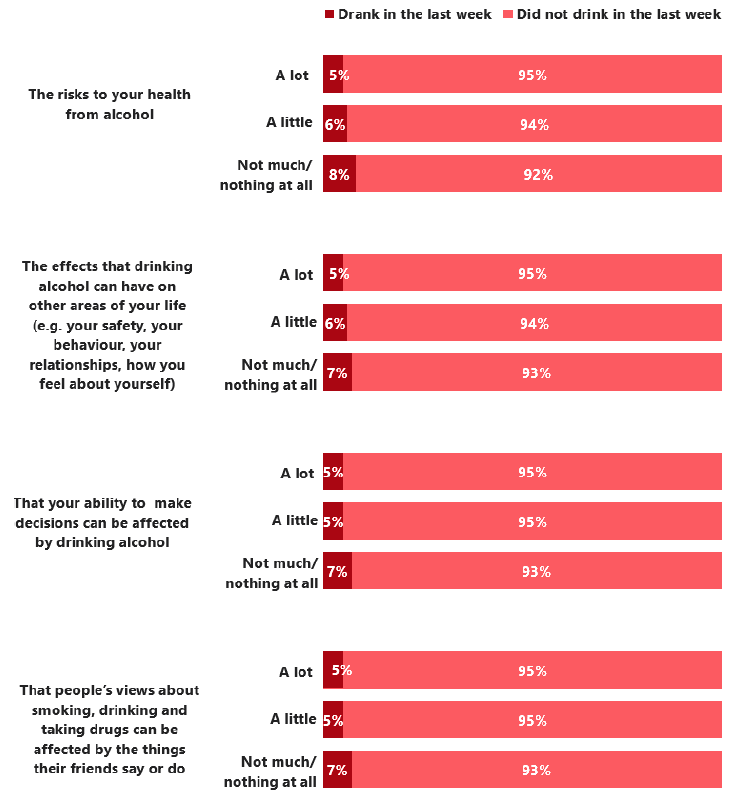
Base: all 13 year olds (for full base size information please see Appendix A)
Table 4.6 – continued – Comparison of prevalence of alcohol use among 15 year olds, by how much they said they had learned about alcohol topics at school (2018)
Q. In school, how much have you learned about the following?
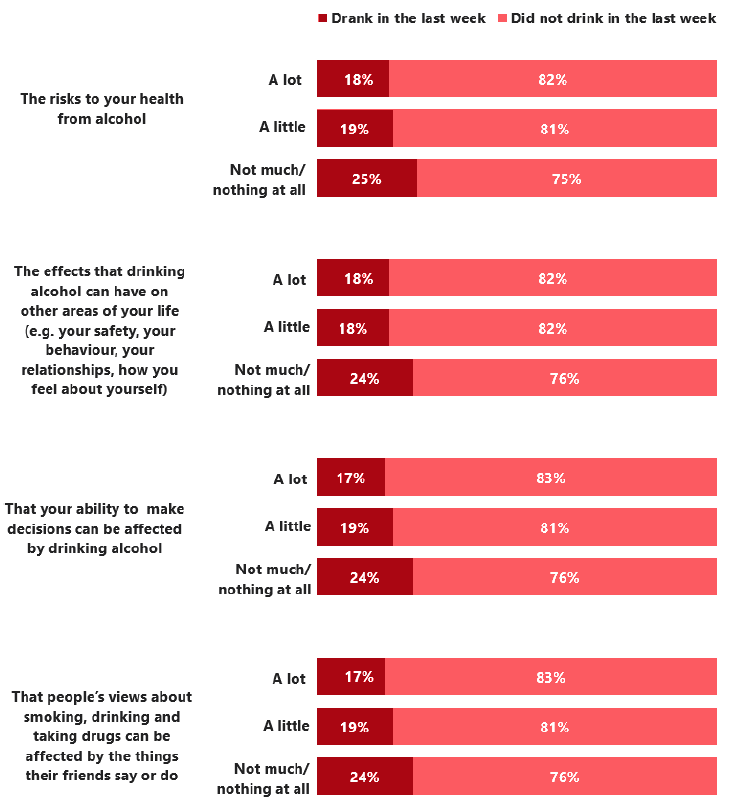
Base: all 15 year olds (for full base size information please see Appendix A)
Confidence about health and wellbeing choices
Pupils were asked how confident they were about a series of aspects of health and wellbeing: having the information they need to make the right choices; saying no to something they don't want to do; knowing where to go for information and support; and avoiding getting into risky situations due to alcohol.
Across the four aspects, most pupils reported feeling very confident or fairly confident. 13 year olds were more likely than 15 year olds to say they felt very confident (Figure 4.7). The only exception was being confident in saying no to doing something that you don't want to do.
Boys were more confident than girls on each aspect. This was true among both age groups. For example, 60% of 15 year old boys, compared with 53% of 15 year old girls, said they were very confident about saying no to doing something they didn't want to do and 62% of 13 year old boys, compared with 56% of 13 year old girls, were very confident about this.
Figure 4.7 Confidence in health and wellbeing choices, by age (2018)
Q Thinking about the future, how confident do you feel about…?
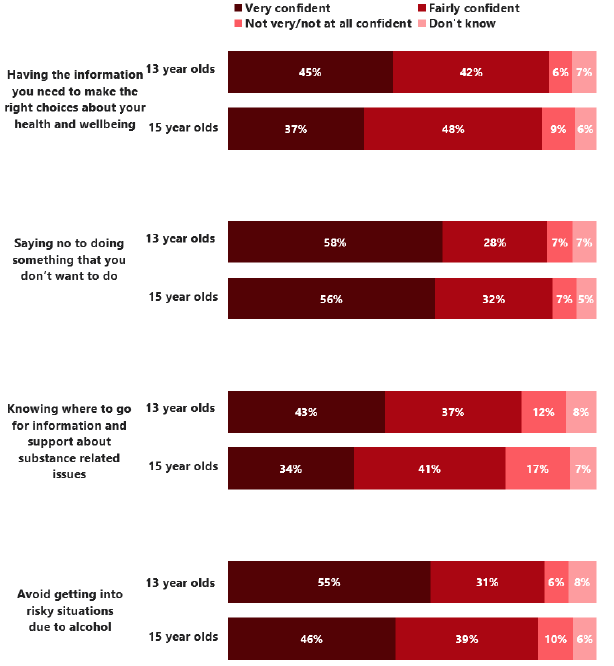
Base: all pupils (for full base size information please see Appendix A)
Confidence in future health and wellbeing choices was associated with drinking behaviour. Across all four statements, pupils who felt confident were less likely to have had a drink in the last week than those who did not.
For example, among 13 year olds, 4% of those who felt very confident and 6% of those who felt fairly confident about saying no to something they didn't want to do, had a drink in the last week. Of those who were not very confident or not confident at all, 11% had drunk alcohol in the last week (Figure 4.8).
The only exception to this was among 15 year olds in relation to the statement 'Knowing where to go for information and support about substance related issues'. Confidence in this issue was not correlated to drinking in the last week.
Figure 4.8 Comparison of prevalence of alcohol use among 13 year old pupils, by confidence in future health and wellbeing choices (2018)
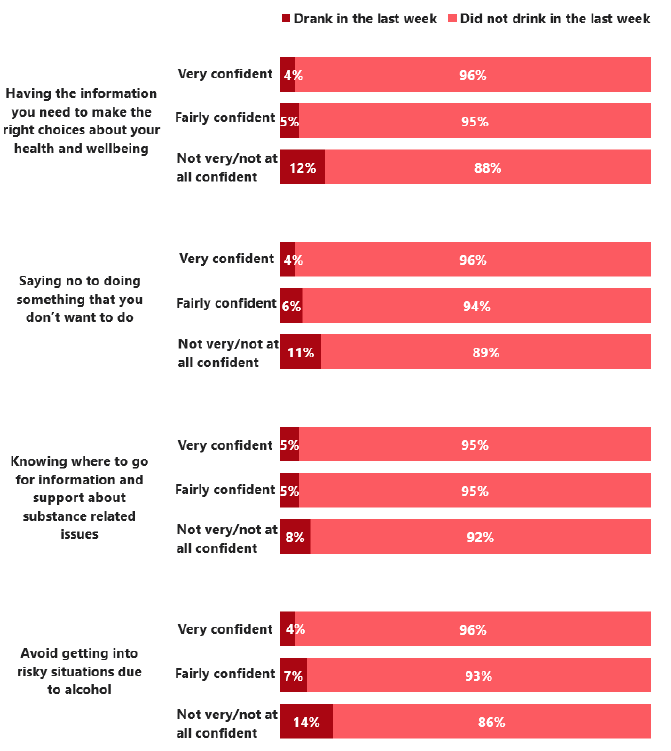
Base: all 13 year old pupils (for full base size information please see Appendix A)
Figure 4.8 – continued – Comparison of prevalence of alcohol use among 15 year old pupils, by confidence in future health and wellbeing choices (2018)
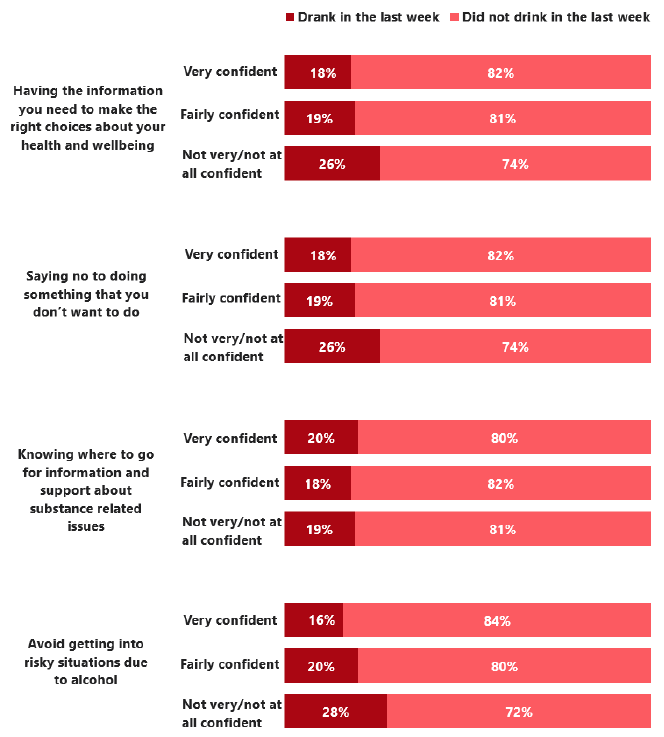
Base: all 15 year old pupils (for full base size information please see Appendix A)
Contact
Email: salsus@gov.scot
There is a problem
Thanks for your feedback